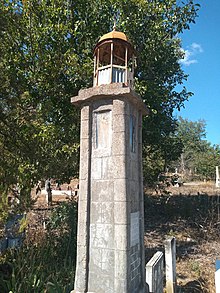Razgrad clock tower
[1] In the stead of the present-day clock tower in Razgrad once there was a different one ending with a steeple in a Gothic style (Yavashov 1930:100),[2] evidence of whose existence was recorded by the German explorer in the service of Denmark Carsten Niebuhr, who visited the town on 22 June 1767.
The designer and constructor of the rebuilt tower was the famous mason Todor Tonchev, born in the tiny mountain hamlet of Durcha near Tryavna.
After the Liberation of Bulgaria from Ottoman rule (1878), Todor Tonchev moved to the village of Kalfa Dere (now Balkanski), where he built a church honoring St. Dimitar.
Hence, the inference that the religious sign on the dome shaped in a half moon was preserved until the end of the 20th century since the time of its installation in 1864, when the tower was rebuilt on the initiative of Midhat Pasha and by Master Todor Tonchev.
According to Bulgarian historian Ananie Yavashov, in the French edition of the travelogues of Irish writer and clergyman Robert Walsh [7] was included additional information about the bell in question.
“It could be concluded”, the author continues, “from the Latin inscription that the bell was forcibly appropriated from an orthodox or catholic church as a trophy – military booty taken by the Turks on their campaigns into one-time Austria-Hungary” (Yavashov 1930:99-100).
Yavashov goes on to explain that the town of Oravicza is in Banat...between Orșova and Temišvar – an area rich in coal, iron, copper, and other ores.
In his article about the clock tower in Razgrad, L. Mikov quotes the observation of M. Harbova expressing the idea that in the 15th – 19th c. in settlements of prevailing Turkish population “the mosque, the konak (Ottoman town hall), and the covered bazaar established themselves as a dominant architectural feature of the town square whereas Bulgarian meeting spaces lacked in such highlights” (Harbova 1984:350-351).
The innovative element introduced by the Revival was the concept of urban zoning encompassing functionally identified areas serving as hubs of the various parts of the settlement.
Around the main square were located artisans’ workshops and merchants’ stores, thus creating a central zone of commercial and manufacturing character.
The outline of these major urban hubs did not have to be shaped by the presence of religious buildings as was typical of Muslim cityscapes, but by craft-and-trade edifices, which provided sources of wealth and a new manner of living.

